Papers by Vera Kashibadze

The diachronic variability of the phene pool structure in the population of the town of Azov for the past five centuries ☯ Диахронная изменчивость фенофонда населения города Азова за последние пять столетий, 2023
The research focuses on the diachronic variability of the phene pool structure in populations of ... more The research focuses on the diachronic variability of the phene pool structure in populations of the Lower Don region for the last five hundred years under condition of a spatial constant (the territory of the town of Azov undergone dramatic history through the marked period). The objects of the study are dental data taken from four cranial series referred to the Golden Horde Age, the Peter I time and the following decades, the beginning of the 20th century, in total number of 232 individuals. The analysis is provided by graphic evaluations of separate markers frequencies. The base of the dental status in the samples under study makes phene complex traced in southern Russian steppe populations from the Bronze Age till the Modern Era. The scale of inter-group variations in markers frequencies is small and falls within the sample error. The results obtained provide the evidence for the certain stability in phene pool structure and population continuity for the town of Azov residents over the last five centuries. It may be concluded for the formation of the population structure to be a long process not linked directly to the historical context. ☯ Целью исследования является изучение диахронной изменчивости фенофонда популяций Нижнего Подонья на протяжении последних пятисот лет в условиях пространственной константы (территория города Азова, пережившего сложную историю на обозначенном отрезке времени). Объектом исследования являлись одонтологические данные по четырем краниологическим сериям разных исторических периодов (золотоордынское время, петровское и постпетровское время, начало ХХ в.) общей численностью 232 индивидуума с территории города Азова. Использован разработанный автором феногеографический метод и его раздел графической оценки диахронной изменчивости отдельных маркеров. Основу одонтологического статуса изученных популяций составляет комплекс характеристик степного населения юга России, прослеживающийся в той или иной мере с эпохи бронзы до Нового времени. Межгрупповой диапазон вариаций частот признаков невелик и находится в пределах ошибки выборки. Полученные результаты позволяют предположить определенную стабильность фенофонда населения города и преемственность его физических характеристик на протяжении последних пяти столетий. Сделан вывод, что сложение популяционной структуры народонаселения – длительный процесс, не связанный напрямую с отдельными историческими событиями.
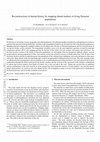
On the base of advantages in gene geography and anthropophenetics the phenogeographical method fo... more On the base of advantages in gene geography and anthropophenetics the phenogeographical method for anthropological research is initiated and experienced using dental data. Statistical and cartographical analyses are provided for 498 living Eurasian populations. Mapping principal components supplied evidence for the phene pool structure in Eurasian populations and for reconstructions of our species history on the continent. The longitudinal variability seems to be the most important regularity revealed by principal components analysis (PCA) and mapping proving the division of the whole area into western and eastern main provinces. So, the most ancient scenario in the history of Eurasian populations was developing from two perspective different groups: western group related to ancient populations of West Asia and the eastern one rooted by ancestry in South and/or East Asia. In spite of the enormous territory and the revealed divergence the populations of the continent have undergone w...

The paper is a compressed narration on the most general results of the RFBR project 11-06-12027, ... more The paper is a compressed narration on the most general results of the RFBR project 11-06-12027, The phene pool structure in Eurasian populations: main stages in composition. Non-metric dental data on 125 fossil Eurasian populations, author’s and published, dated from the Late Pleistocene to the Early Iron Age are analyzed with the use of computer-based phene geography and PCA. The highlights are: 1) the division of the whole area into western and eastern main provinces traced since Paleolithic and Mesolithic; 2) the indicators of the lower molars gracilization, as a peculiar characteristic of Homo sapiens, evolved independently in each province, thus marking two separate ancestral groups; 3) the four-cusped LM2 is a constant marker for west Eurasian populations, while the four-cusped LM1 turns to be an eastern trait during Upper Paleolithic and early Holocene; 4) the earliest localization of gracile LM1, followed, in different ratio, by eastern traits (shoveling, dtc, dw) in the we...

The paper is a compressed narration on the most general results of the RFBR project 11-06-12027, ... more The paper is a compressed narration on the most general results of the RFBR project 11-06-12027, The phene pool structure in Eurasian populations: main stages in composition. Non-metric dental data on 125 fossil Eurasian populations, author’s and published, dated from the Late Pleistocene to the Early Iron Age are analyzed with the use of computer-based phene geography and PCA. The highlights are: 1) the division of the whole area into western and eastern main provinces traced since Paleolithic and Mesolithic; 2) the indicators of the lower molars gracilization, as a peculiar characteristic of Homo sapiens, evolved independently in each province, thus marking two separate ancestral groups; 3) the four-cusped LM2 is a constant marker for west Eurasian populations, while the four-cusped LM1 turns to be an eastern trait during Upper Paleolithic and early Holocene; 4) the earliest localization of gracile LM1, followed, in different ratio, by eastern traits (shoveling, dtc, dw) in the we...
Кашибадзе В.Ф. Одонтология населения Азака // Донские древности, вып. 12, «Азак и мир вокруг него». Материалы Международной научной конференции, Азов, 14-18 октября 2019 г. Отв. ред. Е.Е. Мамичев. Изд-во Азовского музея заповедника, 2019. С. 260-263., 2019
Изучена изменчивость одонтологических фенов-маркеров и их комплексов в двух выборках населения ср... more Изучена изменчивость одонтологических фенов-маркеров и их комплексов в двух выборках населения средневекового города Азака. Показано, что обе серии имеют западноевразийский морфологический статус, но одна из групп воспроизводит предшествующее население Нижнего Подонья, а вторая – население центральных зон Восточной Европы. Преемственность степного оседлого населения и вовлечение новых групп в миграционный процесс в золотоордынское время – два основных фактора сложения фенофонда изученных популяций Азака.
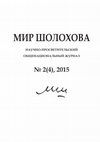
Батиева Е.Ф., Кашибадзе В.Ф. Трагедия гражданской войны глазами антрополога. Исследование костных останков из братской могилы начала ХХ века из г. Азова // Мир Шолохова, № 2 (4), 2015. С. 132-137., 2015
The investigated skeletal remains from the mass burial in Azov town dated by the time of the Civi... more The investigated skeletal remains from the mass burial in Azov town dated by the time of the Civil War are attributed to non-Cossacks Red Army young men died from deplorable conditions in a concentration camp. The Don Cossacks and the non-Cossack inhabitants of the region have similar anthropological characteristics due to the common population history. Key words: anthropology, paleodemography, Don Region, Civil War.
☯
Костные останки из братской могилы времён Гражданской войны из г. Азова принадлежат красноармейцам, молодым мужчинам, не относившимся к казачьему сословию и погибшим из-за ужасающих условий содержания в концлагере. Казачье и неказачье население Нижнего Дона имеет близкие антропологические характеристики вследствие общности процессов генезиса. Ключевые слова: антропология; палеодемография; население Дона; Гражданская война.

Кашибадзе В.Ф., Кашибадзе О.Г. Феногеография одонтологических маркеров в популяциях Евразии и Восточной Европы эпохи бронзы // Stratum plus, № 2, 2016. С. 267-276., 2016
The study addresses the novel technology of compilation of electronic phene-geographical maps wit... more The study addresses the novel technology of compilation of electronic phene-geographical maps within the system of dental data analysis, visualization and cartography of Eurasia developed by the authors. Mapping dental markers frequencies in 16 samples from Eastern Europe and principal components loadings in 20 Bronze Age populations from Eurasia highlights two main migration vectors on the South Russian territory: West-east and north-east for western markers and south-north and north-west for combination of four-cusped first lower molars and other eastern markers. The Lower Don region is a precise line and junction in the marked system of migrations.
☯
Работа основана на применении оригинальной компьютерной технологии построения электронных феногеографических карт в рамках созданной авторами системы анализа, визуализации и картографирования одонтологических данных «Евразия». Картографический анализ распределения частот отдельных одонтологических маркеров в 16 популяциях Восточной Европы и значений главных компонент в 20 популяциях Евразии эпохи бронзы показал два основных вектора миграций в исследуемом регионе юга России: с запада на восток и северо-восток для комплекса западных евразийских признаков и с юга на север и северо-запад для комбинации повышенных частот четырехбугорковых первых нижних моляров с другими маркерами восточной ориентации. Подонье является отчетливым рубежом и перекрестком в обозначенной системе миграций.

Кашибадзе В.Ф., Кашибадзе О.Г. Феногеография одонтологических маркеров в средневековых популяциях Восточной Европы // Stratum plus, №5, 2018. С. 369-374., 2018
The study aims at highlighting the most relevant scenarios in the population history of medieval ... more The study aims at highlighting the most relevant scenarios in the population history of medieval Eastern Europe on the base of dental markers. Compiled electronic phene-geographical maps of the two principal components loadings in 50 groups from the region bring the evidence of east markers domination and the localization of the complex in the Middle Volga region and in the Northern Pontic area. The second relevant combination concentrates in the Center of the Russian Plain and models the average dental status of the living Russians. The intensive expansion of this specific combination eastward and southward has resulted in the current population system in the region.
☯
Исследование ставит своей целью выявить наиболее значимые сценарии в популяционной истории средневековой Восточной Европы на основе одонтологических данных. Проведенный нами картографический анализ значений главных компонент в 50 группах региона показал доминирование комплекса восточных маркеров и его локализацию в Среднем Поволжье и Северном Причерноморье. Вторая по значимости комбинация признаков локализуется в центре Русской равнины и соотносится со средним одонтологическим статусом современных русских. Интенсивная экспансия именно этой комбинации к востоку и к югу и привела к сложению современной популяционной системы региона.

Титов В.В., Кашибадзе В.Ф., Дюжова К.В., Ковалева Г.В., Куршаков С.В., Фролов П.Д., Тесаков А.С. Палеоэкологические характеристики энеолита Нижнего Дона (на основании материалов из многослойного памятника Раздорское I) // Stratum plus, № 2, 2018. С. 303-315., 2018
Razdorskoe 1, one of the best studied Chalcolithic settlements in the south of Eastern Europe, pr... more Razdorskoe 1, one of the best studied Chalcolithic settlements in the south of Eastern Europe, provided data for palaeoenvironmental reconstructions. Six Chalcolithic beds of the studied site yielded synthetic data on anthropology, archaeozoology (including mammals, fishes, and molluscs), and palynology and microalgology, indicating steppe-like landscapes in the vicinity of the site. Extensive floodplain and gully forests were accompanied by pine forests at watersheds. Due to a variety of habitats, the local people practiced rangeland cattle-breeding, and hunted for a variety of large wild ungulates, fur-bearing animals, and birds. Fishery was of a secondary significance in the food economy.
☯
Палеоэкологические реконструкции эпохи энеолита для территории юга Восточной Европы были выполнены по материалам наиболее изученного в регионе поселения Раздорское I. Данные, полученные в результате комплексных антропологических, археозоологических, археоихтиологических, малакологических, палинологических и микроальгологических исследований шести энеолитических слоёв памятника Раздорское I, указывают на остепнённый ландшафт в окрестностях поселения. Обширные пойменные и байрачные леса сочетались с сосновыми борами на водоразделах. Разнообразие биотопов позволяло местному населению заниматься как отгонно-пастбищным скотоводством, так и охотой на разнообразных крупных копытных и пушных зверей, птиц. Рыболовство имело третьестепенное значение в процессе добычи пищи.

Kashibadze V.F. The dental anthropology of the Armenians / Biol.J. of Armenia, vol. XLIII, no.4, P. 285-295. ☯ Кашибадзе В.Ф. Одонтология армян // Биол. журн. Армении, т. XLIII, № 4, 1990. С. 285-295., Jan 15, 1990
Non-metric dental characteristics in 5 ancient and 15 living groups from Armenia are investigated... more Non-metric dental characteristics in 5 ancient and 15 living groups from Armenia are investigated for the first time. The extraordinary homogeneity and compactness in spite of the administrative-territorial affiliation of the selected Armenian samples is revealed. The dental Armenian variant seems to be an ancient and morphologically mature layer in the limits of the dental diversity for the Caucasus highlighting most western features among southern gracile forms.
☯
Впервые проведено исследование морфологических особенностей зубной системы 5 древних и 15 современных армянских групп. Обнаружена чрезвычайная однородность и компактность, не связанная с административно-территориальными особенностями армянских выборок. Армянский вариант зубной системы представляет древний и морфологически зрелый одонтологический пласт в кругу кавказских форм, у которых максимально выражены элементы западного подтипа южного грацильного типа.

Vashaeva V.F. The dental anthropology of the Russians from western and northwestern RF regions. Questions of Anthropology, issue 56, 1977. P. 102-111 ☯ Ващаева В.Ф. Одонтологическая характеристика русских западных и северо-западных областей РСФСР // Вопросы антропологии, вып. 56, 1977. С. 102-111, 1977
Non-metric dental traits in 12 Russian populations from a vast RF western territory, 120-150 each... more Non-metric dental traits in 12 Russian populations from a vast RF western territory, 120-150 each sample size, are investigated. The dental status of the populations under research is transitional between the Northern gracile and the Temperate European complexes, thus distinguishing the western Russians from central and southern Russian groups (Temperate European combinations), as well as from neighbor population from Estonia and North-east of Byelorussia (Northern gracile phenetic type). Urban inhabitants in 6 investigated regions of Russia have similar dental characteristics with ambient rural population. The basic dental dataset is available.
☯
По одонтологической программе исследованы 12 групп русских из 6 западных и северо-западных областей РСФСР общей численностью 1635 человек. Изученные группы по одонтологическим признакам относятся к широкому кругу европеоидных форм и имеют своеобразный промежуточный между северным грацильным и среднеевропейским типами одонтологический комплекс, отличающий их как от русских центра и юга РСФСР, так и от западных соседей — эстонцев и белорусов северо-востока БССР. По системе одонтологических признаков население областных центров мало отличается от окружающего сельского: все группы, взятые на территории одной области, имеют близкие значения признаков.

Voronina V.G., Vashaeva V.F. Primorie // Ethnic odontology of the USSR. Nauka, Moscow, 1979. P. 212-228 ☯ Воронина В.Г., Ващаева В.Ф. Приморье // Этническая одонтология СССР. М.: Наука, 1979. С. 212-228, Oct 24, 1979
Non-metric dental traits in three aboriginal groups from Primorsky Kray (Far East of Russia) - th... more Non-metric dental traits in three aboriginal groups from Primorsky Kray (Far East of Russia) - the Udegheis, the Nanais and the Tahses – 599, 155, 136 accordingly, the total size of population, are investigated. The data obtained highlight the extremes in expression of eastern Eurasian characteristics (world maxima in frequencies of shoveling, crowding, 6-cusped LM1 and world minima in Carabelli trait, diastema, western odontoglyphic phenes, etc.). The distribution in dental markers for mixed (with the Russians) part of the populations is traced. The basic dental dataset is available.
☯
Проведено тотальное одонтологическое исследование трех групп коренного населения Приморского края – удэгейцев, нанайцев и тазов численностью 599, 155, 136 соответственно. Полученные результаты указывают на экстремумы в выраженности признаков восточной ориентации (мировые максимумы частот лопатообразных форм резцов, краудинга, шестибугорковых первых нижних моляров и мировые минимумы значений бугорка Карабелли, диастемы, ряда западных одонтоглифических фенов). Прослежено распределение частот признаков в смешанных (с русскими) сегментах всех трех популяций. Представлены базовые одонтологические табличные данные.

The paper is a compressed narration on the most general results of the RFBR project 11-06-12027, ... more The paper is a compressed narration on the most general results of the RFBR project 11-06-12027, The phene pool structure in Eurasian populations: main stages in composition. Non-metric dental data on 125 fossil Eurasian populations, author’s and published, dated from the Late Pleistocene to the Early Iron Age are analyzed with the use of computer-based phene geography and PCA. The highlights are: 1) the division of the whole area into western and eastern main provinces traced since Paleolithic and Mesolithic; 2) the indicators of the lower molars gracilization, as a peculiar characteristic of Homo sapiens, evolved independently in each province, thus marking two separate ancestral groups; 3) the four-cusped LM2 is a constant marker for west Eurasian populations, while the four-cusped LM1 turns to be an eastern trait during Upper Paleolithic and early Holocene; 4) the earliest localization of gracile LM1, followed, in different ratio, by eastern traits (shoveling, dtc, dw) in the western province is found only in the north of East Europe in Mesolithic and Neolithic; 5) the migrations outbreak highlights Early Metal and Bronze ages: the most intensive dispersals are traced from Asia to the west and from Near East to Siberia; 6) to the breakpoint of the eras the landscape takes on rather recent outlines.
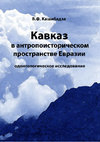
Kashibadze V. F. The Caucasus in the anthropohistorical space of Eurasia. The dental research. SSC RAS Publishers, Rostov-on-Don, Russia, 2006. In Russian, with English Summary., May 2006
The book provides a core source of data for estimation time-space dental variations in Eurasian p... more The book provides a core source of data for estimation time-space dental variations in Eurasian populations through relevant phenetic diversity in the Caucasus and for reconstruction the population history at the continental level.
The research involves original dental data from 86 samples representing 12857 individuals covering all ethnic and sub-ethnic living groups from the Caucasus, and 117 cranial series representing about 1500 skulls from ancient populations dating from the Bronze Age up to the 20th century. The materials were yielded by the author in Georgia, Armenia and the Northern Caucasus during 12 field seasons in 1979-1986. All tabled data is available.
Published data on 393 living and ancient europeoid populations of Eurasia make the comparative space in the research.
The study program covers 32 non-metric dental traits.
All the data operations including statistics and visualization are implemented as routines written in Python. The basic statistics were accomplished by principal component analysis and by the consensus analysis using the bootstrap.
The results provide the evidence of extremely high level of phenetic diversity in Caucasian populations. This diversity seems to be unique in quantity and universal in quality for Eurasian europeoid groups: the dental traits variation in Caucasian populations almost completely covers the phenetic pool of Eurasian western populations.
The dental data on ancient populations of the Caucasus reveals this diversity to be antiquely autochthonic in the region and to have continuity.
The natural and cultural diversity in the region has resulted to the phenetic diversity in Caucasian populations, while the relative isolation of the region has led to conservation and continuity of its ancient ancestral characteristics.
The phylogeny inference provides the evidence of the divergence of living western Eurasian populations from two ancestral populations traced in the phenetic pool of the Caucasus thus identifying the region to adjoin the major source zone in western Eurasia.
The study was supported by the Russian Foundation of Basic Research, grant 03-06-80299.
The book is dedicated to the blessed memory of Academician, Professor Malkhaz Abdushelishvili.
☯
Монография представляет результаты исследования микроэволюционных и расогенетических процессов в народонаселении Кавказа и Евразии по одной из ведущих и современных систем антропологических признаков – одонтологической. Многочисленные оригинальные и сравнительные материалы, современные антропофенетические подходы и использованные методы многомерной статистики представляют не только пространственно-временные характеристики популяционной изменчивости на Кавказе, но и реконструкции процессов сложения фенофонда западных групп Евразии от двух исходных прапопуляций, фенетические параметры которых сохранила система кавказских популяций.
Работа поддержана РФФИ, грант 03-06-80299.
Кашибадзе В.Ф., Кашибадзе О.Г. Астрономический ландшафт в произведениях М.А.Шолохова. Вёшенский вестник, №6. Сборник материалов Международной научно-практической конференции «Шолоховские чтения-2006». — Ростов-на-Дону: Ростиздат, 2006.— С. 46-54., 2006
Кашибадзе В.Ф., Насонова О.Г. Антропология донских казаков: опыт интеграции данных науки и литературы // Труды Южного научного центра РАН, том V: Социальные и гуманитарные науки. Ростов-на-Дону: Изд-во ЮНЦ РАН, 2009. С.167-177., 2009
Антропологическая история донских казаков подразумевает процессы миграции из юго-восточных зон Це... more Антропологическая история донских казаков подразумевает процессы миграции из юго-восточных зон Центральной России и незначительное включение южных и восточных элементов в возрастающей к югу пропорции. Совпадение антропологических данных начала и второй половины ХХ века указывает на преемственность физических характеристик этой группы населения и, отсюда, на выживание группы в процессе известных демографических коллизий. Статистический анализ антропологического портрета донских казаков в романе-энциклопедии М.А.Шолохова «Тихий Дон» показал соответствие портрета научным данным и воспроизведение в романе достоверной антропологической среды.
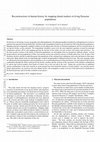
On the base of advantages in gene geography and anthropophenetics the phenogeographical method fo... more On the base of advantages in gene geography and anthropophenetics the phenogeographical method for anthropological research is initiated and experienced using dental data. Statistical and cartographical analyses are provided for 498 living Eurasian populations. Mapping principal components supplied evidence for the phene pool structure in Eurasian populations and for reconstructions of our species history on the continent. The longitudinal variability seems to be the most important regularity revealed by principal components analysis (PCA) and mapping proving the division of the whole area into western and eastern main provinces. So, the most ancient scenario in the history of Eurasian populations was developing from two perspective different groups: western group related to ancient populations of West Asia and the eastern one rooted by ancestry in South and/or East Asia. In spite of the enormous territory and the revealed divergence the populations of the continent have undergone wide scale and intensive time-space interaction. Many details in the revealed landscapes could be backgrounded to different historical events. The most amazing results are obtained for proving migrations and assimilation as two essential phenomena in Eurasian history: the wide spread of the western combination through the whole continent till the Pacific coastline and the envision of the movement of the paradox combinations of eastern and western markers from South or Central Asia to the east and to the west. Taking into account that no additional eastern combinations in the total variation in Asian groups have been found but mixed or western markers' sets and that eastern dental characteristics are traced in Asia since Homo erectus, the assumption is made in favour of the hetero-level assimilation in the Eastern province and of net-like evolution of our species.
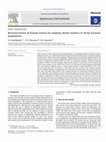
Kashibadze V.F., Nasonova O.G., Nasonov D.S. QI, 284, 3, 2013, Jan 23, 2013
Using advances in gene geography and anthropophenetics, the phenogeographical method for anthropo... more Using advances in gene geography and anthropophenetics, the phenogeographical method for anthropological research was initiated and developed using dental data. Statistical and cartographical analyses are provided for 498 living Eurasian populations. Mapping principal components supplied evidence for the phene pool structure in Eurasian populations, and for reconstructions of Homo sapiens history on the continent. Longitudinal variability seems to be the most important regularity revealed by principal components analysis (PCA) and mapping, indicating the division of the whole area into western and eastern main provinces. So, the most ancient scenario in the history of Eurasian populations developed from two perspective different groups: a western group related to ancient populations of West Asia and an eastern one rooted in ancestry in South and/or East Asia. In spite of the enormous territory and the revealed divergence, the populations of the continent have undergone wide scale and intensive time–space interaction. Many details in the revealed landscapes are background to different historical events. Migrations and assimilation are two essential phenomena in Eurasian history: the widespread of the western combination through the whole continent to the Pacific coastline and the movement of the paradoxical combinations of eastern and western markers from South or Central Asia to the east and west. Taking into account that no additional eastern combinations in the total variation in Asian groups have been found, but that mixed or western markers’ sets and that eastern dental characteristics are traced in Asia since Homo erectus, the assumption is made in favour of the hetero-level assimilation in the eastern province and of net-like evolution of H. sapiens.


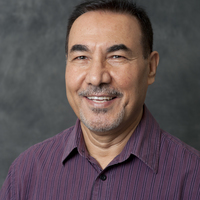


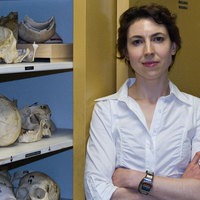





Uploads
Papers by Vera Kashibadze
☯
Костные останки из братской могилы времён Гражданской войны из г. Азова принадлежат красноармейцам, молодым мужчинам, не относившимся к казачьему сословию и погибшим из-за ужасающих условий содержания в концлагере. Казачье и неказачье население Нижнего Дона имеет близкие антропологические характеристики вследствие общности процессов генезиса. Ключевые слова: антропология; палеодемография; население Дона; Гражданская война.
☯
Работа основана на применении оригинальной компьютерной технологии построения электронных феногеографических карт в рамках созданной авторами системы анализа, визуализации и картографирования одонтологических данных «Евразия». Картографический анализ распределения частот отдельных одонтологических маркеров в 16 популяциях Восточной Европы и значений главных компонент в 20 популяциях Евразии эпохи бронзы показал два основных вектора миграций в исследуемом регионе юга России: с запада на восток и северо-восток для комплекса западных евразийских признаков и с юга на север и северо-запад для комбинации повышенных частот четырехбугорковых первых нижних моляров с другими маркерами восточной ориентации. Подонье является отчетливым рубежом и перекрестком в обозначенной системе миграций.
☯
Исследование ставит своей целью выявить наиболее значимые сценарии в популяционной истории средневековой Восточной Европы на основе одонтологических данных. Проведенный нами картографический анализ значений главных компонент в 50 группах региона показал доминирование комплекса восточных маркеров и его локализацию в Среднем Поволжье и Северном Причерноморье. Вторая по значимости комбинация признаков локализуется в центре Русской равнины и соотносится со средним одонтологическим статусом современных русских. Интенсивная экспансия именно этой комбинации к востоку и к югу и привела к сложению современной популяционной системы региона.
☯
Палеоэкологические реконструкции эпохи энеолита для территории юга Восточной Европы были выполнены по материалам наиболее изученного в регионе поселения Раздорское I. Данные, полученные в результате комплексных антропологических, археозоологических, археоихтиологических, малакологических, палинологических и микроальгологических исследований шести энеолитических слоёв памятника Раздорское I, указывают на остепнённый ландшафт в окрестностях поселения. Обширные пойменные и байрачные леса сочетались с сосновыми борами на водоразделах. Разнообразие биотопов позволяло местному населению заниматься как отгонно-пастбищным скотоводством, так и охотой на разнообразных крупных копытных и пушных зверей, птиц. Рыболовство имело третьестепенное значение в процессе добычи пищи.
☯
Впервые проведено исследование морфологических особенностей зубной системы 5 древних и 15 современных армянских групп. Обнаружена чрезвычайная однородность и компактность, не связанная с административно-территориальными особенностями армянских выборок. Армянский вариант зубной системы представляет древний и морфологически зрелый одонтологический пласт в кругу кавказских форм, у которых максимально выражены элементы западного подтипа южного грацильного типа.
☯
По одонтологической программе исследованы 12 групп русских из 6 западных и северо-западных областей РСФСР общей численностью 1635 человек. Изученные группы по одонтологическим признакам относятся к широкому кругу европеоидных форм и имеют своеобразный промежуточный между северным грацильным и среднеевропейским типами одонтологический комплекс, отличающий их как от русских центра и юга РСФСР, так и от западных соседей — эстонцев и белорусов северо-востока БССР. По системе одонтологических признаков население областных центров мало отличается от окружающего сельского: все группы, взятые на территории одной области, имеют близкие значения признаков.
☯
Проведено тотальное одонтологическое исследование трех групп коренного населения Приморского края – удэгейцев, нанайцев и тазов численностью 599, 155, 136 соответственно. Полученные результаты указывают на экстремумы в выраженности признаков восточной ориентации (мировые максимумы частот лопатообразных форм резцов, краудинга, шестибугорковых первых нижних моляров и мировые минимумы значений бугорка Карабелли, диастемы, ряда западных одонтоглифических фенов). Прослежено распределение частот признаков в смешанных (с русскими) сегментах всех трех популяций. Представлены базовые одонтологические табличные данные.
The research involves original dental data from 86 samples representing 12857 individuals covering all ethnic and sub-ethnic living groups from the Caucasus, and 117 cranial series representing about 1500 skulls from ancient populations dating from the Bronze Age up to the 20th century. The materials were yielded by the author in Georgia, Armenia and the Northern Caucasus during 12 field seasons in 1979-1986. All tabled data is available.
Published data on 393 living and ancient europeoid populations of Eurasia make the comparative space in the research.
The study program covers 32 non-metric dental traits.
All the data operations including statistics and visualization are implemented as routines written in Python. The basic statistics were accomplished by principal component analysis and by the consensus analysis using the bootstrap.
The results provide the evidence of extremely high level of phenetic diversity in Caucasian populations. This diversity seems to be unique in quantity and universal in quality for Eurasian europeoid groups: the dental traits variation in Caucasian populations almost completely covers the phenetic pool of Eurasian western populations.
The dental data on ancient populations of the Caucasus reveals this diversity to be antiquely autochthonic in the region and to have continuity.
The natural and cultural diversity in the region has resulted to the phenetic diversity in Caucasian populations, while the relative isolation of the region has led to conservation and continuity of its ancient ancestral characteristics.
The phylogeny inference provides the evidence of the divergence of living western Eurasian populations from two ancestral populations traced in the phenetic pool of the Caucasus thus identifying the region to adjoin the major source zone in western Eurasia.
The study was supported by the Russian Foundation of Basic Research, grant 03-06-80299.
The book is dedicated to the blessed memory of Academician, Professor Malkhaz Abdushelishvili.
☯
Монография представляет результаты исследования микроэволюционных и расогенетических процессов в народонаселении Кавказа и Евразии по одной из ведущих и современных систем антропологических признаков – одонтологической. Многочисленные оригинальные и сравнительные материалы, современные антропофенетические подходы и использованные методы многомерной статистики представляют не только пространственно-временные характеристики популяционной изменчивости на Кавказе, но и реконструкции процессов сложения фенофонда западных групп Евразии от двух исходных прапопуляций, фенетические параметры которых сохранила система кавказских популяций.
Работа поддержана РФФИ, грант 03-06-80299.
☯
Костные останки из братской могилы времён Гражданской войны из г. Азова принадлежат красноармейцам, молодым мужчинам, не относившимся к казачьему сословию и погибшим из-за ужасающих условий содержания в концлагере. Казачье и неказачье население Нижнего Дона имеет близкие антропологические характеристики вследствие общности процессов генезиса. Ключевые слова: антропология; палеодемография; население Дона; Гражданская война.
☯
Работа основана на применении оригинальной компьютерной технологии построения электронных феногеографических карт в рамках созданной авторами системы анализа, визуализации и картографирования одонтологических данных «Евразия». Картографический анализ распределения частот отдельных одонтологических маркеров в 16 популяциях Восточной Европы и значений главных компонент в 20 популяциях Евразии эпохи бронзы показал два основных вектора миграций в исследуемом регионе юга России: с запада на восток и северо-восток для комплекса западных евразийских признаков и с юга на север и северо-запад для комбинации повышенных частот четырехбугорковых первых нижних моляров с другими маркерами восточной ориентации. Подонье является отчетливым рубежом и перекрестком в обозначенной системе миграций.
☯
Исследование ставит своей целью выявить наиболее значимые сценарии в популяционной истории средневековой Восточной Европы на основе одонтологических данных. Проведенный нами картографический анализ значений главных компонент в 50 группах региона показал доминирование комплекса восточных маркеров и его локализацию в Среднем Поволжье и Северном Причерноморье. Вторая по значимости комбинация признаков локализуется в центре Русской равнины и соотносится со средним одонтологическим статусом современных русских. Интенсивная экспансия именно этой комбинации к востоку и к югу и привела к сложению современной популяционной системы региона.
☯
Палеоэкологические реконструкции эпохи энеолита для территории юга Восточной Европы были выполнены по материалам наиболее изученного в регионе поселения Раздорское I. Данные, полученные в результате комплексных антропологических, археозоологических, археоихтиологических, малакологических, палинологических и микроальгологических исследований шести энеолитических слоёв памятника Раздорское I, указывают на остепнённый ландшафт в окрестностях поселения. Обширные пойменные и байрачные леса сочетались с сосновыми борами на водоразделах. Разнообразие биотопов позволяло местному населению заниматься как отгонно-пастбищным скотоводством, так и охотой на разнообразных крупных копытных и пушных зверей, птиц. Рыболовство имело третьестепенное значение в процессе добычи пищи.
☯
Впервые проведено исследование морфологических особенностей зубной системы 5 древних и 15 современных армянских групп. Обнаружена чрезвычайная однородность и компактность, не связанная с административно-территориальными особенностями армянских выборок. Армянский вариант зубной системы представляет древний и морфологически зрелый одонтологический пласт в кругу кавказских форм, у которых максимально выражены элементы западного подтипа южного грацильного типа.
☯
По одонтологической программе исследованы 12 групп русских из 6 западных и северо-западных областей РСФСР общей численностью 1635 человек. Изученные группы по одонтологическим признакам относятся к широкому кругу европеоидных форм и имеют своеобразный промежуточный между северным грацильным и среднеевропейским типами одонтологический комплекс, отличающий их как от русских центра и юга РСФСР, так и от западных соседей — эстонцев и белорусов северо-востока БССР. По системе одонтологических признаков население областных центров мало отличается от окружающего сельского: все группы, взятые на территории одной области, имеют близкие значения признаков.
☯
Проведено тотальное одонтологическое исследование трех групп коренного населения Приморского края – удэгейцев, нанайцев и тазов численностью 599, 155, 136 соответственно. Полученные результаты указывают на экстремумы в выраженности признаков восточной ориентации (мировые максимумы частот лопатообразных форм резцов, краудинга, шестибугорковых первых нижних моляров и мировые минимумы значений бугорка Карабелли, диастемы, ряда западных одонтоглифических фенов). Прослежено распределение частот признаков в смешанных (с русскими) сегментах всех трех популяций. Представлены базовые одонтологические табличные данные.
The research involves original dental data from 86 samples representing 12857 individuals covering all ethnic and sub-ethnic living groups from the Caucasus, and 117 cranial series representing about 1500 skulls from ancient populations dating from the Bronze Age up to the 20th century. The materials were yielded by the author in Georgia, Armenia and the Northern Caucasus during 12 field seasons in 1979-1986. All tabled data is available.
Published data on 393 living and ancient europeoid populations of Eurasia make the comparative space in the research.
The study program covers 32 non-metric dental traits.
All the data operations including statistics and visualization are implemented as routines written in Python. The basic statistics were accomplished by principal component analysis and by the consensus analysis using the bootstrap.
The results provide the evidence of extremely high level of phenetic diversity in Caucasian populations. This diversity seems to be unique in quantity and universal in quality for Eurasian europeoid groups: the dental traits variation in Caucasian populations almost completely covers the phenetic pool of Eurasian western populations.
The dental data on ancient populations of the Caucasus reveals this diversity to be antiquely autochthonic in the region and to have continuity.
The natural and cultural diversity in the region has resulted to the phenetic diversity in Caucasian populations, while the relative isolation of the region has led to conservation and continuity of its ancient ancestral characteristics.
The phylogeny inference provides the evidence of the divergence of living western Eurasian populations from two ancestral populations traced in the phenetic pool of the Caucasus thus identifying the region to adjoin the major source zone in western Eurasia.
The study was supported by the Russian Foundation of Basic Research, grant 03-06-80299.
The book is dedicated to the blessed memory of Academician, Professor Malkhaz Abdushelishvili.
☯
Монография представляет результаты исследования микроэволюционных и расогенетических процессов в народонаселении Кавказа и Евразии по одной из ведущих и современных систем антропологических признаков – одонтологической. Многочисленные оригинальные и сравнительные материалы, современные антропофенетические подходы и использованные методы многомерной статистики представляют не только пространственно-временные характеристики популяционной изменчивости на Кавказе, но и реконструкции процессов сложения фенофонда западных групп Евразии от двух исходных прапопуляций, фенетические параметры которых сохранила система кавказских популяций.
Работа поддержана РФФИ, грант 03-06-80299.